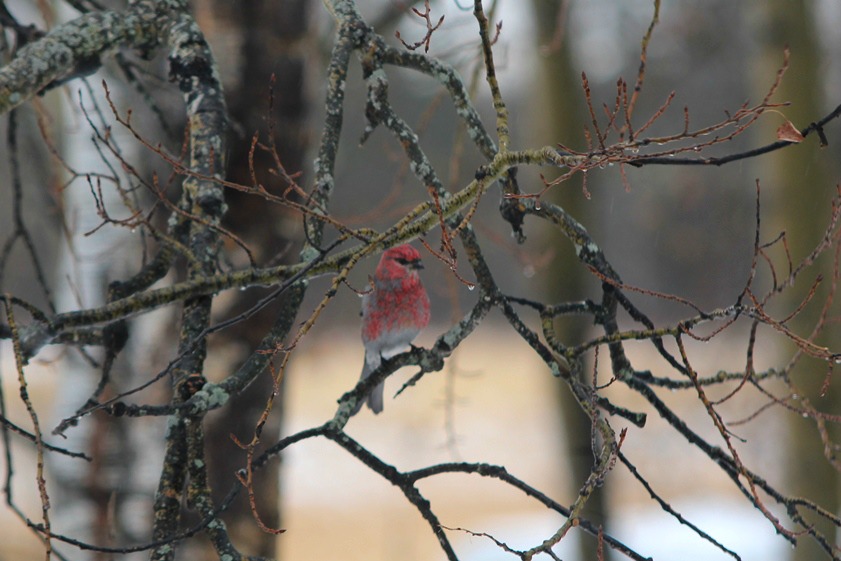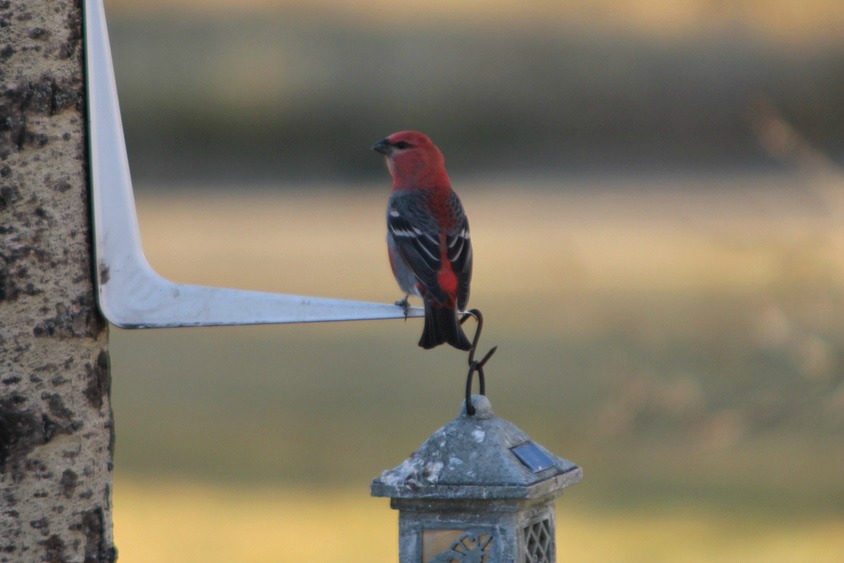Posted by Janet Plante
Living in the Boreal Forest is great, but it is even better when we get Chinooks. A Chinook is a warm wind that brings warmer temperatures, often above freezing. We have experienced going from -40 degrees Celsius (-40 Fahrenheit) to 10 above Celsius (50 above Fahrenheit) within 24 hours. The warmer weather allows us to get outside and enjoy the birds. In this picture, taken in January, you can see the water dripping from the tree branches.
This year we are blessed with an abundance of not only the traditional chickadees and common redpolls but pine grosbeaks seem to have taken over our feeders. We have a wonderful chorus and it is great to have more than the usual chick-a-dee-dee-dee.
At times we have counted more than a dozen pine grosbeaks both male and female.
Occasionally we see an evening grosbeak but it seems they have moved on to allow the pine grosbeak cousins a chance at the feeders. There even seems to be a red-breasted nuthatch or two that remains in residence, just to balance off the songbook.
In the middle of December during of one of those Chinooks I was able to watch both the pine grosbeaks and the common redpolls taking a bath in the snow. It was wonderful! They would burrow into the snow and then throw it off. Difficult to take a picture, but great to watch.
You can tell this bird has been having a bath as his feathers look wet. If you look close you can see the water coming down from the spout just in front of this pine grosbeak.
The common redpolls were bathing too. It looked like they were digging a hole in the snow. What fun!
Abstract From The Wilson Journal of Ornithology:
I report a case of snow bathing by House Finches (Carpodacus mexicanus), apparently the first for this species. As many as 15 finches bathed together, three to four at a time, in 18 cm of fresh loose snow in a manner typical when birds bathe in water or dirt: wings fluttered near the sides to spray the snow over the body with back and head plumage erected while the breast was pressed into the snow. Relatively few accounts of birds bathing in snow have been published. I found 23 prior reports of snow bathing for 16 North American species, mostly Passeriformes but including Falconiformes, Galliformes, Strigiformes, and Piciformes. Bathing in loose or uncompacted snow occurred more often than in wet or crusted snow, and there was a tendency for more than one bird to engage in snow bathing during each event. Brevity of accounts prevented identification of other factors that may be frequently associated with snow bathing. Bathing in snow is a routine behavior for some bird species, such as ptarmigan, and European accounts indicate that it is undoubtedly more widespread among North American species than shown by review of the literature.
Paul Hendricks, Montana Natural Heritage Program, Natural Science 205, University of Montana, Missoula, MT 59812, USA











Watching birds in a snowbath would be great fun! It was almost 90 degrees here today so I especially enjoyed your descriptions and photos.
I have never seen birds snowbathing before. What fun! The Pine Grosbeaks are especially lovely. Great post!